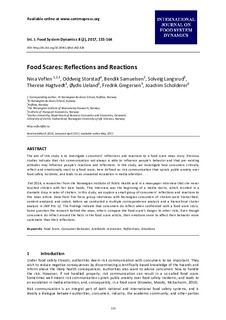| dc.contributor.author | Veflen, Nina | |
| dc.contributor.author | Storstad, Oddveig | |
| dc.contributor.author | Samuelsen, Bendik Meling | |
| dc.contributor.author | Langsrud, Solveig | |
| dc.contributor.author | Hagtvedt, Therese | |
| dc.contributor.author | Ueland, Øydis | |
| dc.contributor.author | Gregersen, Fredrik Alexander | |
| dc.contributor.author | Scholderer, Joachim | |
| dc.date.accessioned | 2018-06-29T12:30:27Z | |
| dc.date.available | 2018-06-29T12:30:27Z | |
| dc.date.created | 2017-06-13T12:51:09Z | |
| dc.date.issued | 2017 | |
| dc.identifier.citation | International Journal on Food System Dynamics. 2017, 8 (2), 155-164. | nb_NO |
| dc.identifier.issn | 1869-6945 | |
| dc.identifier.uri | http://hdl.handle.net/11250/2503811 | |
| dc.description.abstract | The aim of this study is to investigate consumers’ reflections and reactions to a food scare news story. Previous studies indicate that risk communication not always is able to influence people’s behavior and that pre-existing attitudes may influence people’s reactions and reflections. In this study, we investigate how consumers critically reflect and emotionally react to a food scare, here defined as risk communication that spirals public anxiety over food safety incidents, and leads to an unwanted escalation in media attention. Fall 2014, a researcher from the Norwegian Institute of Public Health said in a newspaper interview that she never touched chicken with her bare hands. This interview was the beginning of a media storm, which resulted in a dramatic drop in sales of chicken. In this study, we explore a small group of consumers’ reflections and reactions to this news article. Data from five focus group interviews with Norwegian consumers of chicken were transcribed, content analyzed, and coded, before we conducted a multiple correspondence analysis and a hierarchical cluster analysis in JMP Pro 12. The findings indicate that consumers do reflect when confronted with a food scare story. Some question the research behind the news, others compare the food scare’s danger to other risks. Even though consumers do reflect around the facts in the food scare article, their emotions seem to affect their behavior more systematic than their reflections. | |
| dc.description.abstract | Food Scares: Reflections and Reactions | |
| dc.language.iso | eng | nb_NO |
| dc.rights | Attribution-NonCommercial-NoDerivatives 4.0 Internasjonal | * |
| dc.rights.uri | http://creativecommons.org/licenses/by-nc-nd/4.0/deed.no | * |
| dc.title | Food Scares: Reflections and Reactions | nb_NO |
| dc.title.alternative | Food Scares: Reflections and Reactions | nb_NO |
| dc.type | Journal article | nb_NO |
| dc.type | Peer reviewed | nb_NO |
| dc.description.version | publishedVersion | |
| dc.source.pagenumber | 155-164 | nb_NO |
| dc.source.volume | 8 | nb_NO |
| dc.source.journal | International Journal on Food System Dynamics | nb_NO |
| dc.source.issue | 2 | nb_NO |
| dc.identifier.doi | 10.18461/ijfsd.v8i2.826 | |
| dc.identifier.cristin | 1475680 | |
| dc.relation.project | Norges forskningsråd: 262306 | nb_NO |
| dc.relation.project | Norges forskningsråd: 262303 | nb_NO |
| dc.relation.project | Nofima AS: 201704 | nb_NO |
| dc.relation.project | Nofima AS: 201703 | nb_NO |
| dc.relation.project | Nofima AS: 10834 | nb_NO |
| dc.relation.project | Nofima AS: 201702 | nb_NO |
| dc.relation.project | Norges forskningsråd: 262308 | nb_NO |
| dc.relation.project | Norges forskningsråd: 233738 | nb_NO |
| cristin.unitcode | 192,11,0,0 | |
| cristin.unitname | Handelshøgskolen | |
| cristin.ispublished | true | |
| cristin.fulltext | original | |
| cristin.qualitycode | 1 | |

